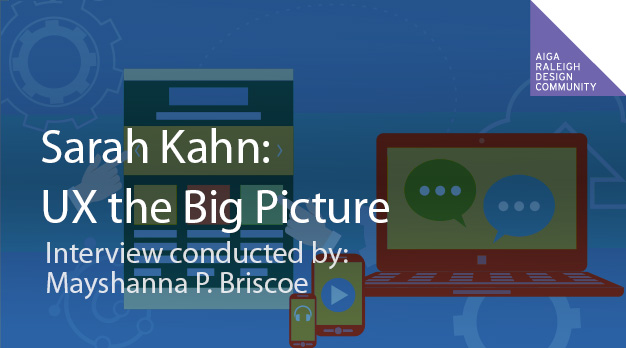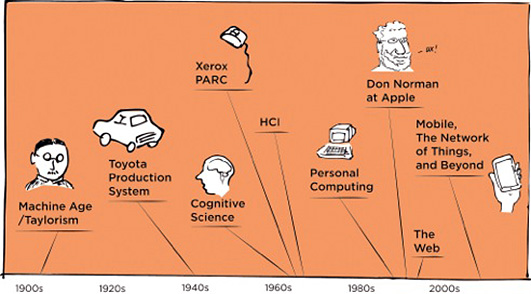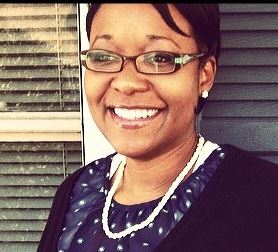
You asked and we found the answers, or at least the amazing people who know the answers. Part of UX discussion we are interviewing Sarah Kahn a rogue librarian turned UX/UI developer. Sarah went to grad school at the School of Information and Library Science at UNC-Chapel Hill, where she realized that people are more interesting than books. She has been designing and building web application interfaces since 2008. Over the years she has gained a variety of experience in interaction design, usability evaluation, qualitative and quantitative research, and assessing web accessibility. She currently is a Senior UX Designer at Deutsche Bank. Her previous work has been at places like Adzerk, NC LIVE, and Lulu.com. She also is a co-founder at Fogbeam Labs.
 What is your background in creative community?
What is your background in creative community?
I’ve been making websites as a hobby since the late 90s. I’ve always enjoyed the creative aspect, but in terms of schooling I’m coming from the human-computer interaction/usability realm. I studied library and information science at UNC, and got a MLS in 2008. Since then I’ve been doing UX and UI at a few different companies. I used to co-lead Refresh the Triangle, but currently I’m a co-leader of Girl Develop It.
What is your design process?
When I come into a project, I begin by gathering as much information as possible. If it’s an existing product, I’ll ask for analytics. If it’s new, I’ll talk to stakeholders, customers, and customer support folks if there are any. From there, the specific details will depend on the project. The key things I’ll work on will be establishing a process for gathering feedback from users, and iterating on the design. Whether that means getting people in a room in front of a whiteboard, or drafting task flows in Balsamiq and posting to Notable and discussing over Skype, or walking around with a paper prototype and getting random people to touch where they’d click with a pencil, that all can vary.
Once things are pretty well settled, I’ll prototype in code. I usually get a dev instance of whatever project I’m working on that allows me to deliver code to the developers. I’ll work with them on the details of implementation, and will close the loop by asking for customer feedback as soon as the real thing is delivered. In a big organization like DB, that means sharing a version before it goes to production. At smaller companies that I’ve worked at, that meant flipping the feature flag for certain customers before turning it on for everyone. That allows the opportunity to get early feedback and fix or change things before it goes to production.

What is User Experience (UX) Design? What is User Interface (UI) Design?
The difference between UX and UI is subtle, and there can be a lot of overlap. I like this image to help explain: http://design.org/blog/difference-between-ux-and-ui-subtleties-explained-cereal
UX is the big picture, the holistic view of solving the problem from end to end. In a nutshell, people have an experience when they use something. Whether that something is a physical artifact, a software application, or a website. User experience design is the art and science of making that experience effective and satisfying.
The UI is the tangible tool that the user can use to complete tasks. But it’s not the entire tool, and the experience of interacting with the tool is the User Experience.
UX folks are all over the map. A recent study of user experience professionals showed that people reported over 16 separate tasks as part of their main job. UXers are all over the map, and we wear many hats.
Personally, In my years as a UX professional, I’ve done remote and in-person usability testing, metrics analysis, content strategy, graphic design, front-end development, wire framing, information architecture exercises, brainstorming, strategizing, researching, QAing, and a lot of sketching.
The specifics of what ux professionals do will vary with the team and the project. But the biggest constants in my experience are:
- advocacy and education. Advocacy both for the users and for UX methodologies. Education on what the problems users are facing every day are, as well as what can be done to fix it.
- proposing solutions and actionable plans. It’s not enough to know there’s a problem. If you’re the one that points out a problem, they’re going to look to you to figure out how to fix it. Which is why there’s an inherent component of leadership to working on any UX role.
- facilitating communication. Show me a website that doesn’t work well, and I’ll show you an organization (or team) with fractured or dysfunctional internal communication.
In my experience, UI Design is a little more focused. When someone calls herself a UI Designer, I think more about visual design and implementation and the tasks associated with those.
What comes first, the UI or UX Designer?
UX usually comes first, because it’s integral in product definition. UX is the ‘How’ to Product’s ‘What’. UI is a piece of the ‘How’. Often it will be the same person doing UX and UI, unless it’s a really big project.
 UX and UI seem to appear out of nowhere, why do you think UX and UI are becoming so important to companies like Deutsche Bank?
UX and UI seem to appear out of nowhere, why do you think UX and UI are becoming so important to companies like Deutsche Bank?
The field of UX has actually been around longer than you might think. For an excellent history, check out this article: http://www.uxbooth.com/articles/where-ux-comes-from/
When I think about companies that have a devoted fan base, I think of Apple. Not everyone has customers who will camp out for two weeks for a chance to buy their products. People do it for Apple because they have staked their entire business model on making things that are beautiful and easy to use.
Websites and applications are just like anything else that people need to have interactions with. If it’s difficult and unpleasant, they won’t come back. Your website is competing not only with the websites of your direct competitors, but with search engines, news aggregators, social media sites, video sites, photo gallery sites. . . the list goes on and on.
In short, you’ve got approximately 6 seconds to prove to your users that your site is easy to use and will help them achieve their end goal with a minimum of time and attention.
For companies like DB, time is money. Any time that employees can save using their internal tools is money earned. This is the main reason for devoting resources to UX.
How does UX design impact the overall design process?
It’s just another layer in the process. Having clearly defined UX requirements from the start helps to smooth the road for branding and look and feel. A lot of the hard work gets sorted out earlier.
I read a blog post where you discussed Lean UX, how does Lean UX work and when is it appropriate for a project?
It depends on the team. Personally, I follow Lean UX all the time, whether I’m working with a big team or a small team. That means I spend less time creating detailed design artifacts, and more time iterating, discussing, and trying different things with users. I also deliver my designs in production-ready HTML/CSS to my development team. It can be a harder sell in a waterfall-heavy project or organization, but at the end of the day everyone seems to like the ability to change their mind for cheaper. Emphasizing the price tag can help sell it to clients.
Is there any other fun fact or knowledge you would like to share with our readers?
UX is not that mysterious! You’re probably already doing it and you don’t know it! I periodically teach a class through Girl Develop It that’s open to anyone. Join the meet up group to see when it will be offered next. Click here for date and more information.
How do you keep current on the latest information about UX design or design in general?
Two things- UX-focused organizations like TriUXPA, Intent, IxDA and this website: uxdesign.cc
If you want to learn more about Sarah Kahn:
Twitter: @aarahkahak
Email: sarahk@girldevelopit.com
Website: kahnlab.com

Author of this post: Mayshanna Pandora Briscoe is a Freelance Graphic Designer, Mixed Media Artist and Aspiring Blogger. She has a B.A. in International Business and A.A.S. in Advertising and Graphic Design with a Certificate in Web Technology. When she is not in her studio she can be found experimenting with a new recipe, posting pictures of her design life or food on Instagram, or making memories with her fan club (aka her friends, family and dogs).